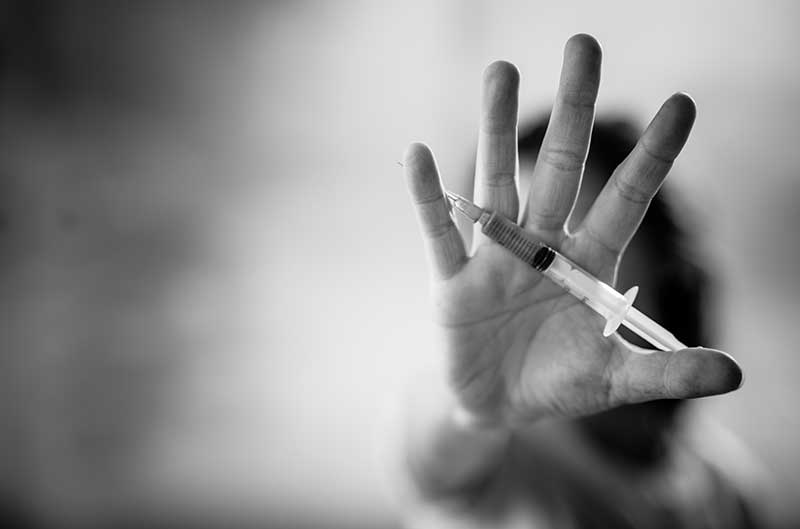Five Important Things to Know About Drug Addiction
Mental HealthPosted:

The opioid crisis continues to make national and local headlines, and those who seek treatment face a long road of recovery as well as a stigma that often keeps them from getting the treatment and support they need.
We can all help the fight by learning more about addiction, so here are a few things to remember:
Not a Choice
First, and most importantly: Drug addiction is not a choice. It is a disturbance of brain chemistry brought on by the misuse of drugs. Here is a breakdown:
Opioids activate the brain’s reward center to release dopamine, boosting feelings of pleasure and satisfaction. They’re the same feelings we get from eating chocolate, holding a loved one’s hand, having sex or engaging in other activities that make us feel good.
Dopamine triggers the midbrain to make a lasting memory that associates these good feelings with the circumstances and environment where they occurred.
These memories, called conditioned associations, can lead a substance abuser to crave drugs when re-encountering those people, places, or things: For example, when a cigarette smoker says, “When I’m in a bar, I have to have a cigarette.”
Opioid dependence and withdrawal result when the base of the brain — the locus ceruleus (LC) – undergoes changes. In the LC, neurons stimulate wakefulness, breathing, blood pressure, and general alertness.
The opioid molecules that link to receptors in the LC cause drowsiness, slowed respiration, low blood pressure — all signs of respiratory suppression that indicate a person's rate and depth of breathing are lower than normal.
When it is repeatedly exposed to opioids, the LC adjusts by increasing the production of certain neurotransmitters.
The increased production offsets the opioid suppression, and the opioid user feels more or less normal. But when opioids are not present to suppress the enhanced noradrenaline activity, excessive noradrenaline triggers jitters, anxiety, muscle cramps, and diarrhea – common symptoms of withdrawal.
This turns into a vicious cycle, producing increased tolerance that eventually leads to dependence. The merry-go-round that is drug-addicted behavior has begun.
Anyone is at risk
Addiction is an equal opportunity affliction that affects people without regard to economic circumstance, education, race, geography, IQ, or any other factors.
No one is immune from the disease of addiction. However, it still remains unclear why some people are more susceptible than others. More research needs to be done.
The stigma of addiction hurts the human family
I’ve heard people call those with substance use disorders hopeless, a waste of resources, scumbags, slugs, lowlifes, and other horrible names that we would never call other types of patients. These are mothers, fathers, sons, daughters, husbands, wives, sisters, brothers, nieces, nephews -- in other words, they’re human beings who deserve our understanding and compassion.
Mental health disease
The seemingly hopeless addict is a frightened human being who may or may not have other mental health disorders. Dismissed and marginalized by our current systems, the addict feels helpless and defeated, and worse, may have given up hope of having a normal life.
My personal belief is that drug addiction is seen as a personal choice, a character flaw, a weakness of spirit instead of what it really is: a chronic mental health disease characterized by cycles of remission and relapse. Also, until recently, we have not had effective treatment options to offer except for abstinence, which is only effective for a very small number of people.
Effective treatment is available
Multiple studies show medication-assisted therapy (MAT) successfully treats opioid addiction. Buprenorphine (subutex and suboxone) or methadone has been shown to:
- Relieve cravings and withdrawal symptoms
- Reduce relapse
- Reduce the transmission of communicable disease such as HIV and hepatitis C
- Decrease the crime rate associated with drug abuse
These medications help correct the impaired brain chemistry that drives addict behavior. Used in tandem with support services such as counseling and group work, these medications can reduce opioid addiction.
Want to Learn More?
Lee Health Addiction Medicine offers treatment, including MAT, counseling and Narcotics Anonymous, which offers 12-step support for men and women seeking recovery. For friends and family members affected by someone else’s addiction, I encourage you to reach out to Nar-Anon, a 12-step program where you will find support, encouragement and ideas on how to cope.
 Catherine Murtagh-Schaffer, PA, is a cardiothoracic physician assistant. She serves as the program lead for the opioid disorder treatment and substance abuse response team.
Catherine Murtagh-Schaffer, PA, is a cardiothoracic physician assistant. She serves as the program lead for the opioid disorder treatment and substance abuse response team.
If you would to contribute to Healthy News, please contact us at Social@LeeHealth.org

